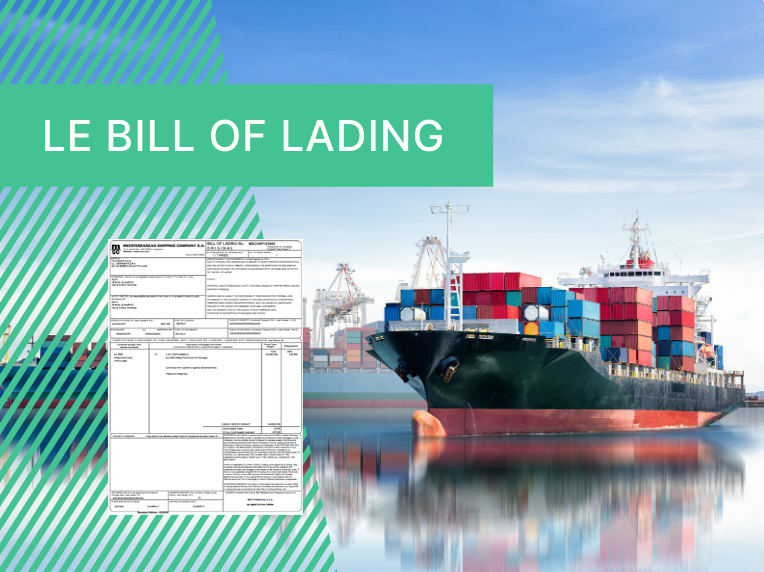The bill of lading (BOL) is one of the most important things you need for your freight shipping because it is the evidence of your contract with your carrier, forwarder, or freight broker. Whether you’re opting for less-than-truckload (LTL), ocean freight, or intermodal shipping, most, if not all, service providers won’t ship your freight without one.
So what is the BOL exactly?
Through this article you’ll learn what a BOL is, what’s in it, how to read it, as well as other aspects of the BOL that you should know about as a shipper.
Hopefully, by the time you’ve finished this article, you’ll have a good grasp of this very important document for your shipping needs.
What is a Bill of Lading (BOL) ?
A bill of lading is a document given by the shipper to the carrier at the time of pickup. It includes all the relevant information of the shipment, including but not limited to: pickup and delivery addresses, contact information, total weight, piece count, freight class, NMFC code, additional services, special instructions, commodity description, freight dimensions, billing party information, shipping/purchase order numbers, and much more.
See? It’s a lot of stuff. Now, let’s break it down a bit.
To “lade” means to load cargo on the ship or vessel.
The BOL is the receipt of the transaction between you and your carrier. It is a legally binding document that can also serve as a document of title, which allows the person holding it to claim ownership of the freight.
It contains the relevant information about your shipment so logistics providers can process and price their service accordingly. These details are (but not limited to):
- Pickup and delivery addresses
- Contact information
- Total weight
- Piece count
- Freight class
- NMFC code
- Additional services
- Special instructions
- Commodity description
- Freight dimensions
- Billing party information
- Shipping/purchase order numbers
- BOL number
Who issues the bill of lading?
A BOL is often issued by your carrier, broker, or forwarder and you just have to fill out the details in the blank form.
However, when it comes to truckload shipping, some carriers would allow their customers to make their own BOL for LTL shipments while it’s actually more common in full truckload (FTL) freight for shippers to use their own BOL.
Here at FreightPros, we allow our LTL customers to customize their freight BOLs through our transportation management system. Our team can always supply one for FTL freight if needed and, additionally, a full truckload BOL will also require pallet counts and signatures.
How to Read a BOL: Bill of Lading Information
What do those aforementioned details in a BOL exactly mean?
Here’s a brief rundown of some very common terms you will encounter:
- Names and addresses of both the shipper and receiver (consignee) and both should be easily readable in the document.
- Purchase orders or reference numbers that are required for pickup upon delivery.
- Special instructions for the carrier that may be needed to ensure the integrity of the package.
- Date of pickup that the consignee can expect the goods to arrive.
- Description of items like the quantity of goods, dimensions and weight, and information about the material.
- Packaging type i.e. cartons, crates, pallets or drums used during shipping.
- NMFC code that corresponds to the freight class of the shipment, which is based on density, ease of handling, liability, and value.
- Dept. of Transportation hazardous material destination whereby hazardous items must be disclosed and which handling measures are necessary.
- BOL number given by the issuer of the BOL.
At the absolute minimum, these things must be notated on the BOL or else the freight probably won’t be picked up and you could get charged a dry run by the carrier. If your shipment is LTL, then you’ll also need the freight class of the shipment.
What MUST be on the BOL?
There are a few things that must be on the Freight BOL. First, the delivery address. How else is the carrier going to know where to take the freight? Next, the total weight and count of the shipment. You also must include the commodity a.k.a. what exactly are you shipping?
Finally, you’ll need the billing party information a.k.a. who’s paying for this shipment once it’s delivered?
These are hardly the only things that should be on a bill of lading, but at the absolute minimum, these things must be notated on the BOL or else the freight probably won’t be picked up, and you could get charged a dry run by the carrier. If your shipment is LTL, then you’ll also need the freight class of the shipment.
Here at FreightPros, we provide our LTL customers with their own customized freight BOLs using our transportation management system. When moving full truckload freight it’s more common for the shipper to provide their own bill of lading, but our team can always supply one if necessary. Additionally, a truckload BOL will also require pallet counts and signatures.
How a BOL is issued
A bill of lading is usually issued per shipment, per container or per truckload, but it also depends on your requirements as the shipper. It can be determined by the purchase order, kind of goods you’re shipping, letter of credit, and many other factors.
So it’s certainly possible that you may have more than one BOL for your shipment, where it may be two full truckloads under one BOL or one truckload with two BOLs.
Common types of Bill of Lading (BOL)
There are many kinds of BOLs that have different terms in the contract and are used in different shipping scenarios. Here’s a list that describes the 18 of the most common ones.
1. Master bill of lading
This type of BOL is issued by the shipping line, trucking company, or basically the owner/operator of the transport vessel. This is also the type of BOL your freight forwarder or broker has with the carrier and it contains most of the same detailed information about your cargo.
2. House bill of lading
Also known as a forwarder’s bill of lading, this type of BOL is given by the broker, forwarder, or the non-vessel operating common carrier (NVOCC) to their clients.
3. Open bill of lading
Also known as a negotiable bill of lading, this type specifies that the cargo can be transferred from one consignee to another as long as there is the consignee’s signature. The consignee is usually a named party pre-determined by either the carrier, a bank, or the importer of the goods.
4. Order bill of lading
This type states that the cargo will only be delivered to the person or party determined by the shipper, which is often according to the consignee (i.e. your online store’s customer). To ensure the safety of delivery, the agent or middleman responsible for the delivery must verify the bill. Also considered as a negotiable bill of lading, it is the most used type of BOL in the world.
5. Bearer bill of lading
This type denotes that the cargo will be delivered to whoever possesses the bill of lading and the consignee may be unspecified originally or be negotiated upon delivery of the freight. It is used for bulk shipments that are released in smaller quantities.
6. Straight bill of lading
Also known as a non-negotiable bill of lading, this type consigns the cargo to one specific person and neither the endorser nor the endorsee is prioritized when claiming ownership of the delivery. More often than not, the consignee has to make an advance payment first before they can receive the goods and he/she may or may not be required to show the original bill upon receipt, depending on the laws of the destination country.
7. Received for shipment bill of lading
This type is the BOL given by the carrier confirming that the goods have been received but not necessarily laden onto the ship or transport vessel yet. This is used as a temporary BOL when the vessel is late and will be replaced by a Shipped BOL when the cargo is loaded on the ship.
8. Shipped bill of lading
This type is issued when the cargo is onboard the vessel and now binds the owner of the vessel with the carrier.
9. Ocean bill of lading
This type allows the cargo to be transported via ocean freight, both nationally and internationally.
10. Inland bill of lading
This type allows the carrier to transport the shipment via land (road or rail) but only within domestic boundaries.
11. Airway bill of lading
This is the type issued by an air freight company or forwarder and this is usually considered non-negotiable unless the cargo is consigned to the order of the shipper.
12. Clean bill of lading
The type states that the cargo is loaded in good condition aboard the vessel and cannot explicitly declare a defective condition of the packaging and/or the goods inside. But if the shipment turns out to be damaged or is missing in quantity, it is replaced by a Dirty BOL.
13. Dirty bill of lading
This type has a clause that says the shipowner can declare the condition of the cargo as “dirty” when he finds out that there is broken cargo, incorrect quantity of goods specified, significant damage in the packaging, etc.
14. Through bill of lading
This type serves as a legal document that allows the cargo to directly pass through domestic and international borders, be transferred from one distribution center to another, and be transported across multiple modes of transport. It also requires to include an Inland or Ocean BOL depending on the final destination of the shipment.
15. Combined transport bill of lading
Also known as a multimodal transport BOL, this type states that there are at least two modes of transport involved when shipping the cargo.
16. Direct bill of lading
This type of BOL is for shipments that are to be picked up and delivered by the same vessel.
17. Stale bill of lading
This type denotes that when the cargo arrives at the port first before the bill of lading itself, the BOL is considered “stale”.
18. Surrender bill of lading
This type is issued by an exporter to an importer signifying the transfer of ownership once the cargo is received.
Differences between the Freight Bill and the Bill of Lading
When dealing with your broker or carrier, you will also encounter the freight bill, which may look similar to the BOL. But there are key differences between the two.
A freight bill’s purpose is to actually support the BOL by providing more detailed financial information and other clarifying details about the shipment. For example, the bill of lading will only specify the date and location but information about additional costs incurred during transport is found in the freight bill. It is what accountants look at for accounting and financing purposes like a freight audit. And if you’re interested in saving money in your shipping operations, looking at the freight bill is a great way to start.
However, unlike the bill of lading which is legally binding, a freight bill isn’t a document of service level agreement. The BOL can be used to settle disputes between the shipper and the carrier while the freight bill isn’t usually considered as evidence.
What is Consignee of the Bill of Lading?
The consignee is the person entitled to receive the shipment from the carrier and the type of bill of lading dictates how the goods are transferred.
A straight bill of lading identifies the consignee as the actual person and depending on the laws of the destination country, he/she may not be required to show the original bill when claiming the goods. And more often than not, the consignee has to make an advance payment first before they can receive the goods.
A negotiable bill of lading states the consignee as a named party pre-determined either by the carrier, a bank, the importer of goods, etc. The consignee usually pays through credit or cash against documents.
A bearer bill of lading states that the consignee is the person who possesses the original bill of lading and can be negotiated by physical delivery.
Bill of Lading Types and Examples
There are several kinds of bill of lading used in different situations but is primarily categorized according to its basis of execution and method of operation.
Basis of execution
- Straight bill of lading
The cargo is consigned to one specific person and neither the endorsee nor the endorsee is prioritized when claiming ownership of the delivery. Also known as a non-negotiable bill of lading, this type is often used for military purposes.
- Open bill of lading
The cargo can be transferred from one consignee to another. Also known as a negotiable bill of lading, the goods can be transferred multiple times as long as there is the consignee’s signature.
- Bearer bill of lading
The cargo is delivered to those whoever possesses the bill of lading. The consignee may be unspecified originally or endorsed as blank. This type is used for bulk shipments that are released in smaller quantities.
- Order bill of lading
The cargo is only delivered to the bonafide holder of the bill, as determined by the shipper or consignee’s order. To ensure the safety of delivery, an agent who makes delivery orders must verify the bill. Also considered as a negotiable bill of lading, it is the most used type in the world.
Method of operation
- Received for shipment bill of lading
The bill is sent to the carrier by an agent or middleman. This confirms that the goods have been received but not yet laden on to the ship.
- Shipped bill of lading
It is issued when the cargo is onboard the vessel and binds the shipowner to the carrier directly.
- Clean bill of lading
The bill states that the cargo is in good condition aboard the vessel and cannot explicitly declare a defective condition of the packaging and/or the goods inside.
- Through bill of lading
A legal document that allows the cargo to be directly delivered from one location to another. It allows the shipment to pass domestic and international borders because it serves as a contract of carriage and receipt of the cargo.
- Combined transport bill of lading
The bill states that the cargo is transported by multiple modes i.e. by land, sea, or air.
- Dirty bill of lading
The bill has a clause where the shipowner can declare the condition of the cargo to be “dirty” when he finds out that there is broken cargo, incorrect quantity of goods specified, significant damage in the packaging, etc.
The importance of using the correct Bill of Lading
It’s paramount to use the right BOL so you can avoid unforeseen freight charges and unnecessary time constraints (like the shipment being delivered to the wrong address). That means the BOL contains all the details about your shipment and the terms and conditions are also favorable for you.
An important thing to consider when shipping LTL freight
If you’re using LTL shipping (which can sometimes have more moving parts compared to full truckload), it’s highly advisable to use the BOL of your carrier or broker so you can see what are the actual services needed to ship your freight safely and on-time. Those costs may even change once the cargo is in transit.
But should it happen that the incorrect BOL was used for a shipment, contact your carrier or broker (if you’re using one) immediately to see how they can correct what went wrong. Sometimes it may require a letter of authorization, especially when it involves the person or party the shipment is billed to. That is just one possibility and more often than not these changes will also cost the shipper an additional fee — greatly underscoring why the right BOL from the get-go is important.
Conclusion
There is a lot to learn about the bill of lading because it is essentially the contract of service between you and your freight shipping service provider. It’s important to nail just about every detail in it so your cargo is delivered with the least amount of hiccups as possible.
The bill of lading is just one aspect of freight shipping, and you can learn more about other aspects through our Beginner’s Guide to Freight Shipping. It contains an overview of the basics of truckload shipping, details about how your freight is actually quoted, an extensive list of freight terms commonly used, and many other information to help you make shipping as smooth as possible.





4 comments
Mr WordPress
September 17, 2015 at 1:49 pm
Hi, this is a comment.
To delete a comment, just log in and view the post's comments. There you will have the option to edit or delete them.
admin
October 8, 2015 at 4:35 pm
Curabitur nec orci libero. Vivamus nec libero ac dolor ultrices vulputate. Donec consectetur enim suscipit metus tempus tempus. Nam id lacus libero. Interdum et malesuada fames ac ante ipsum primis in faucibus. Suspendisse sit amet aliquet nulla, sit amet blandit ex. Sed finibus augue sed odio mollis, et rhoncus dui tincidunt. Nunc ullamcorper quam eu cursus fringilla. Nulla facilisi. Sed vitae gravida leo. Nulla ultricies metus vel accumsan gravida. Cum sociis natoque penatibus et magnis dis parturient montes, nascetur ridiculus mus. Maecenas faucibus, mauris eu suscipit ornare, elit erat commodo libero, eu condimentum felis diam ac leo.
admin
October 8, 2015 at 4:35 pm
Nulla ut velit neque. Praesent massa orci, molestie ut posuere a, tincidunt nec dui. Quisque feugiat sem sed orci sagittis, id dictum eros sodales. Nullam ac ante elit. Vivamus et nisl augue. Aenean vitae justo nulla. Nam auctor dui vel purus iaculis consequat. Morbi quis finibus magna, quis malesuada diam.
admin
October 8, 2015 at 4:35 pm
Lorem ipsum dolor sit amet, consectetur adipiscing elit. Cras pellentesque massa et metus mattis, a auctor est tincidunt. Morbi tincidunt dolor a tincidunt auctor. Vestibulum a metus vitae eros hendrerit sodales nec in sem. Vestibulum in libero mauris. Sed finibus, sapien vitae ornare iaculis, enim nunc viverra justo, nec volutpat leo erat et magna. Integer tempor nisi et est aliquet, eget ullamcorper ante placerat.